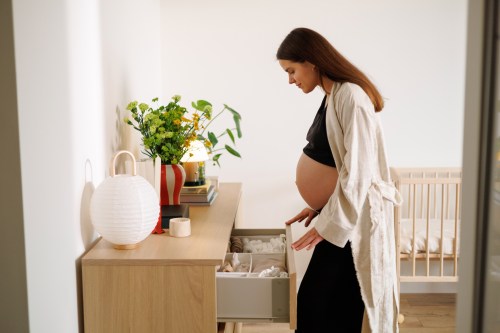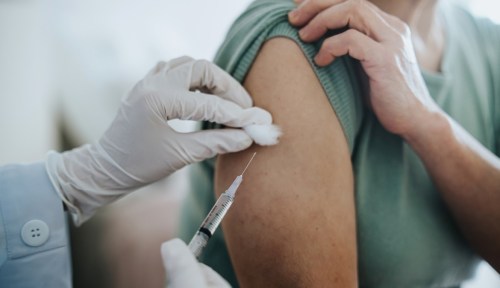Cringe-y confession: I am obsessed with my fertility, even though I’m single and not currently trying to get pregnant. If I could check my fertility status every day—as in, take a test that said, “Yes, you could 100 percent make a baby today if you wanted to!”—I definitely would.
For many women, fertility concerns are likewise ever-present, albeit probably in a less neurotic and more practical way. Fertility monitoring—once a science relevant only to women trying to conceive—is now billed as an au natural method for avoiding contraceptives, AKA birth control, too. As the market for products that help women understand and track their cycles for these two very important purposes expands, tech-based devices have begun to proliferate.
Los Angeles-based OB/GYN Candice Daneshvar, MD, is quick to clarify, however, that while fertility trackers and apps may be novel, they do not necessarily represent new science. Instead, they rely on traditional fertility-prediction methods—e.g. basal body temperature, progesterone levels, etc.—which she believes are not altogether reliable. “Basically, [all] the apps are doing is replacing the traditional paper and pencil charts that women used to use to avoid pregnancy,” she explains. (And if your main aim is to prevent pregnancy…these family planning methods are generally considered to be less effective than condoms, the pill, and other more ubiquitous methods of birth control.)
Below, find a breakdown of the buzziest of these baby-making (or, uh, baby-avoiding) fertility apps.
Option one: Urinary luteinizing hormone-based trackers
According to Dr. Daneshvar, this is a preferred method for tracking fertility because it’s able to show ovulation in real time. Basically, your body produces something called a luteinizing hormone (LH), which Dr. Daneshvar says increases in your body around 36 hours before ovulation (signaling to your ovaries that it’s time to release an egg). Thus, by measuring your urine’s LH levels, you can know when you’re about to ovulate and plan accordingly.
“Measurement of urinary luteinizing hormone (LH) is more expensive but also effective,” Dr. Daneshvar says. “Women typically begin testing their urine one or two days before the expected surge so that the increase over baseline levels can be clearly observed.”
This isn’t exactly new thinking—urinary luteinizing hormone tests are available at the drugstore and at the doctor’s office. However, there could be advantages to tech-based versions like Mira, which was released to the market this summer.
Mira Fertility, $200
Like those drugstore ovulation tests, Mira tests for the presence of LH in your urine; however, what sets the device apart from these over-the-counter disposable sticks is that its wand actually measures how much of the hormone is present (so you can better identify the spike that indicates ovulation). Another differentiator is that the Mira app will help track data to learn your cycle, predict ovulation, and flag any irregularities. Just note: It’s currently backordered until January.
Option two: Body-temperature-based trackers
Basal body temperature (BBT) is another commonly-used fertility marker. BBT is essentially your body’s temperature when it’s at rest (like when you’re asleep). “When ovulation occurs, the ovaries will be making higher amounts of the hormone progesterone,” says Zain Al-Safi, MD, an assistant clinical professor of reproductive endocrinology and infertility at UCLA. “This will have an effect on the hypothalamus, leading to an increase in body temperature over the next few days after ovulation.”
However, neither he nor Dr. Daneshvar consider this method ideal for family planning. “It cannot be used to time intercourse that same cycle to achieve pregnancy, as by the time of temperature rise, ovulation has already occurred and it is too late,” says Al-Safi. He caveats, however, that BBT can be used to predict future ovulation in those with regular cycles. (If your cycle is typically irregular, this is a harder marker to predict.) This is what the tech below promises.
Daysy Fertility, $330
This thermometer syncs with an app to help you plan or avoid pregnancy using your basal body temperature. Each morning, you’ll take your temp first thing and enter whether or not you’re on your period. The device will then calculate your fertility status (whether you’re in your “fertile window” or not) over the next 24 hours to help you plan accordingly. The so-called Lady-Comp algorithm it uses to do so has, says the brand, an accuracy rate of 99.3 percent.
Wink, $129
Wink operates in much the same way as does Daysy. It’s a rigged oral thermometer that’s used to track your early AM basal body temperature and decode your fertility patterns accordingly. It automatically syncs with the Kindara app, where you can enter additional data such as the consistency of your cervical fluid, whether or not you had sex, and so on in order to better understand your cycle.
Yono, $150
This device sits in the ear canal like a pair of wireless earbuds. It measures basal body temperature overnight so that in the morning you can download data simply by syncing the device to the Yonolabs app. (Note: The earbuds are only compatible with the Apple version of the app, not the Android version.)
Option three: Electrolyte-level-based trackers
Dr. Al Saif tells me that studies have shown that electrolyte changes are associated with ovulation (although it should be noted that most of these studies are decades-old), which is why this type of test may be effective in predicting fertility. The idea is that the changes in your hormones also affect the amount of electrolytes (like sodium and potassium) in your blood, with both of those peaking at ovulation. OvaCue is the only product on the market which utilizes this marker.
OvaCue, $350
OvaCue is different from other fertility trackers on the market in that it uses two different devices which, sorry, insert into two different orifices. Both measure electrolyte levels: one in your saliva, and one in your cervical mucus. The former is used every day to predict ovulation windows. The latter is used to confirm that ovulation occurred. All data is logged on the handheld monitor, and then fertility and infertility windows are color-coded. Users also have access to OvaGraph, a desktop and mobile app where they can chart their data for a more robust education about their bodies.
Option four: Trackers that use misc. biological and behavioral markers
As a general note, Dr. Al-Safi says that the data collection outlined below does not necessarily improve accuracy over a tracker that tests for temperature alone.
Ava Bracelet, $299
This wearable tracker measures nine different biological parameters while you sleep at night (so, no probes, no peeing on sticks, nada). These include: resting pulse rate, which increases when you’re fertile; skin temperature; breathing rate; heart rate variability ratio, which is the variation in time interval from one heartbeat to the next; perfusion, the process of supplying blood to the body’s tissues; your sleep cycle, e.g. REM versus light sleep; hydration and sweating patterns; and heat loss. Sync it with the Ava app, and in the morning you’ll have access to data on all of the above as well as feedback on your fertility status.
Ovia Fertility, Free
Unlike the device-based trackers on this list, Ovia relies on you to track details such as BBT through outside means. Then, you record that data into the app and receive feedback on your fertility accordingly. You can also interact with an online community of fellow app users The company claims that it helps reduce the average time it takes a couple to get pregnant from four to six months down to two.
What differentiates this app with, say, the average period tracker is that the company’s amassing data to determine patterns which may help it more accurately predict your ovulation. Back in 2014, its founder told The Guardian that Ovia’s parent company, Ovuline, is collecting 24,000 cycle-related data points per hour and using them for two large studies on fertility—one looking at potential early pregnancy signs and another looking at whether there’s a way to “score” someone’s fertility.
Conceivable, $199 per month
Wellness junkies (raises hand) may well find the relatively heftier price tag of this app to be worth the expense, as Conceivable does more than track your cycle/fertility. Its main focus, in fact, is to look for specific barriers to fertility within your data and then troubleshoot them with you, holistically.
To begin, you take a quiz which asks you to speak to a number of factors related to your cycle, including the length of menstruation, regularity, etc. Then, it provides you feedback on potential pain points, e.g. your period is shorter than average, and gives you ongoing instructions for “improving” in this area (including personalized supplements delivered to your door). Lifestyle factors are taken into account, e.g. how often you sleep and what you eat, and behavior modification is a big part of Conceivable’s fertility prescriptions.
Glow, Free
This app tracks the same indicators as most of the other fertility trackers on this list, and then some. It wants to know things like which positions you tried if you had sex, and what your partner’s eating or how active they’re being, etc. It also is the only app to also track male fertility (because hey, it takes two!). Like Ovia, you can access an online community of fellow couples trying to conceive. Glow also offers fertility consultations and discounts for members on fertility treatments.
Trying to conceive? Here are three ways to boost your fertility naturally. Also, you may want to try hiring a fertility coach, avoiding sunscreen, and being wary of your yoga mat.
Sign Up for Our Daily Newsletter
Get all the latest in wellness, trends, food, fitness, beauty, and more delivered right to your inbox.
Got it, you've been added to our email list.











